Impact and Influence of Macro Environment on Organisation and its Strategies
VerifiedAdded on 2023/01/13
|15
|4372
|35
AI Summary
This assignment discusses the impact and influence of the macro environment on an organisation and its strategies. It includes a PESTEL analysis to assess the political, economic, social, technological, environmental, and legal factors affecting the organisation. It also analyzes the stakeholder matrix and provides strategies to improve competitive edge and market position.
Contribute Materials
Your contribution can guide someone’s learning journey. Share your
documents today.
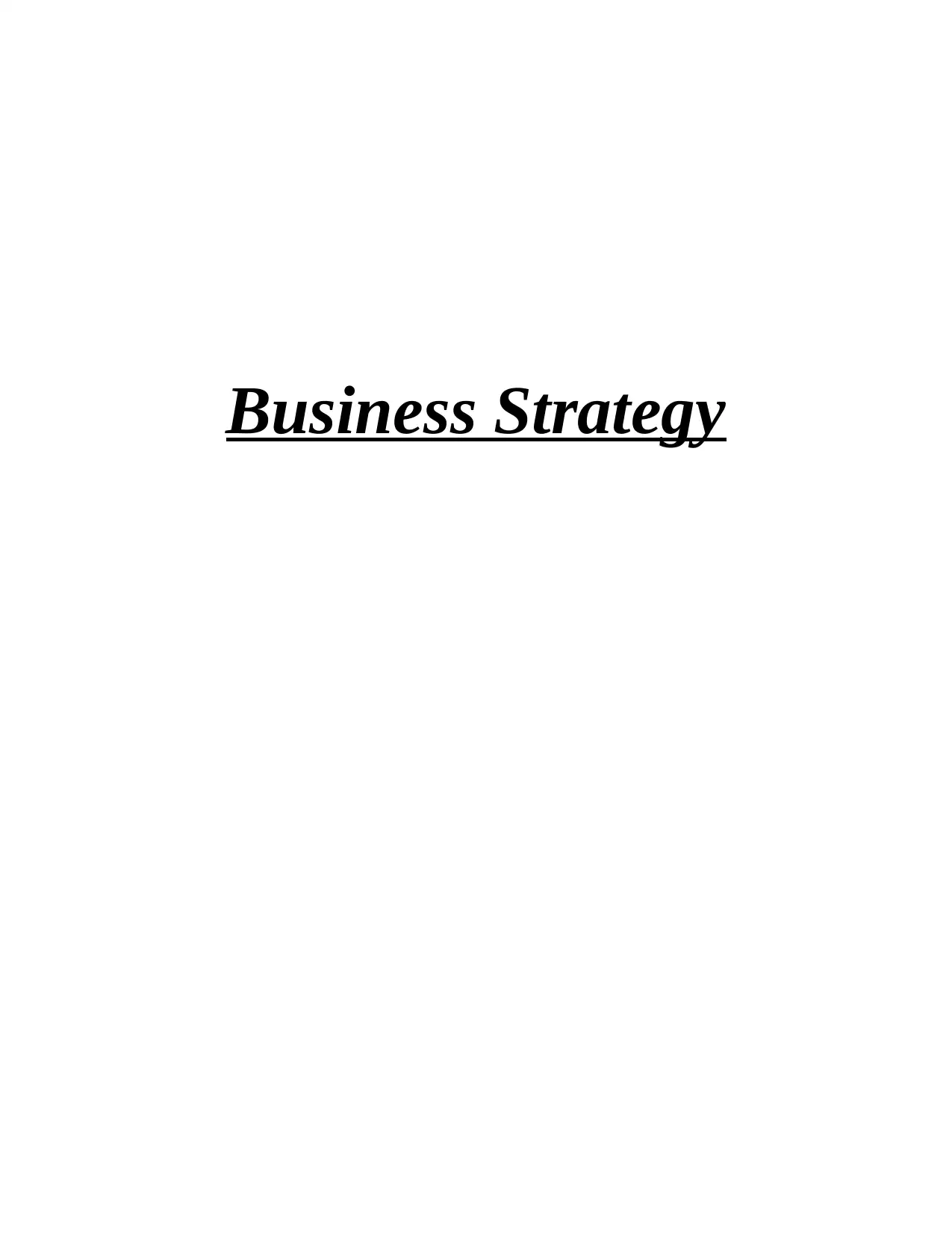
Business Strategy
Secure Best Marks with AI Grader
Need help grading? Try our AI Grader for instant feedback on your assignments.

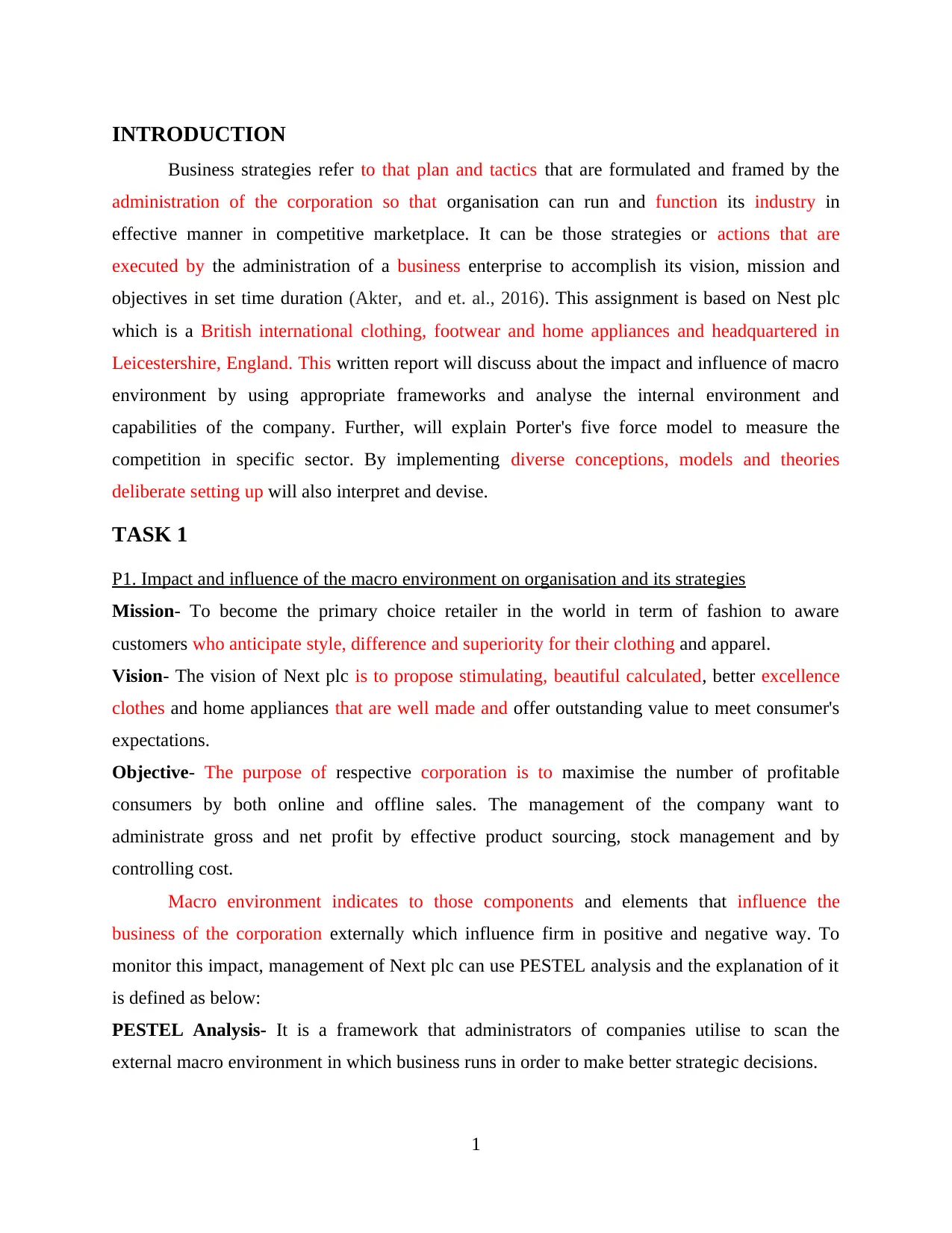
INTRODUCTION
Business strategies refer to that plan and tactics that are formulated and framed by the
administration of the corporation so that organisation can run and function its industry in
effective manner in competitive marketplace. It can be those strategies or actions that are
executed by the administration of a business enterprise to accomplish its vision, mission and
objectives in set time duration (Akter, and et. al., 2016). This assignment is based on Nest plc
which is a British international clothing, footwear and home appliances and headquartered in
Leicestershire, England. This written report will discuss about the impact and influence of macro
environment by using appropriate frameworks and analyse the internal environment and
capabilities of the company. Further, will explain Porter's five force model to measure the
competition in specific sector. By implementing diverse conceptions, models and theories
deliberate setting up will also interpret and devise.
TASK 1
P1. Impact and influence of the macro environment on organisation and its strategies
Mission- To become the primary choice retailer in the world in term of fashion to aware
customers who anticipate style, difference and superiority for their clothing and apparel.
Vision- The vision of Next plc is to propose stimulating, beautiful calculated, better excellence
clothes and home appliances that are well made and offer outstanding value to meet consumer's
expectations.
Objective- The purpose of respective corporation is to maximise the number of profitable
consumers by both online and offline sales. The management of the company want to
administrate gross and net profit by effective product sourcing, stock management and by
controlling cost.
Macro environment indicates to those components and elements that influence the
business of the corporation externally which influence firm in positive and negative way. To
monitor this impact, management of Next plc can use PESTEL analysis and the explanation of it
is defined as below:
PESTEL Analysis- It is a framework that administrators of companies utilise to scan the
external macro environment in which business runs in order to make better strategic decisions.
1
Business strategies refer to that plan and tactics that are formulated and framed by the
administration of the corporation so that organisation can run and function its industry in
effective manner in competitive marketplace. It can be those strategies or actions that are
executed by the administration of a business enterprise to accomplish its vision, mission and
objectives in set time duration (Akter, and et. al., 2016). This assignment is based on Nest plc
which is a British international clothing, footwear and home appliances and headquartered in
Leicestershire, England. This written report will discuss about the impact and influence of macro
environment by using appropriate frameworks and analyse the internal environment and
capabilities of the company. Further, will explain Porter's five force model to measure the
competition in specific sector. By implementing diverse conceptions, models and theories
deliberate setting up will also interpret and devise.
TASK 1
P1. Impact and influence of the macro environment on organisation and its strategies
Mission- To become the primary choice retailer in the world in term of fashion to aware
customers who anticipate style, difference and superiority for their clothing and apparel.
Vision- The vision of Next plc is to propose stimulating, beautiful calculated, better excellence
clothes and home appliances that are well made and offer outstanding value to meet consumer's
expectations.
Objective- The purpose of respective corporation is to maximise the number of profitable
consumers by both online and offline sales. The management of the company want to
administrate gross and net profit by effective product sourcing, stock management and by
controlling cost.
Macro environment indicates to those components and elements that influence the
business of the corporation externally which influence firm in positive and negative way. To
monitor this impact, management of Next plc can use PESTEL analysis and the explanation of it
is defined as below:
PESTEL Analysis- It is a framework that administrators of companies utilise to scan the
external macro environment in which business runs in order to make better strategic decisions.
1
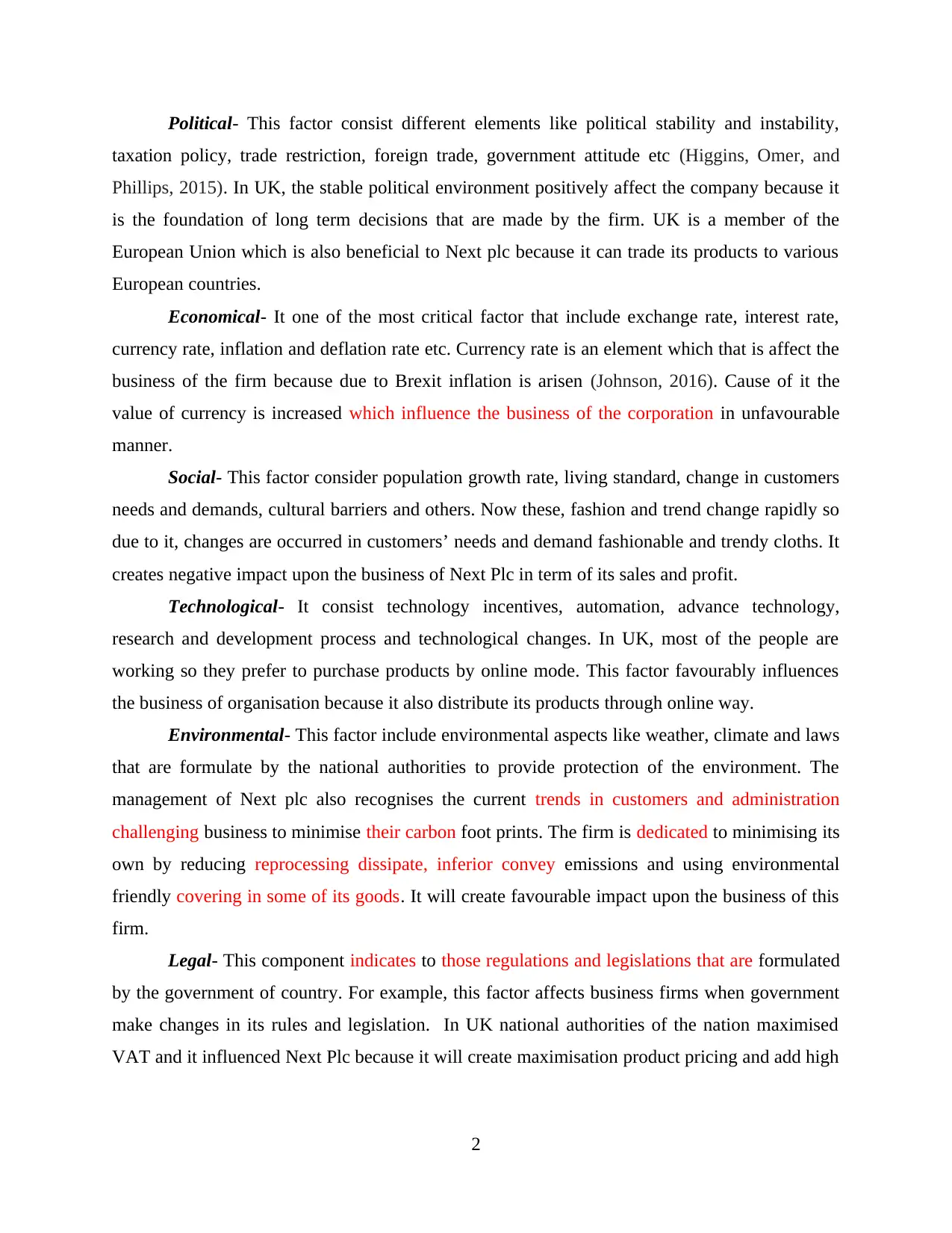
Political- This factor consist different elements like political stability and instability,
taxation policy, trade restriction, foreign trade, government attitude etc (Higgins, Omer, and
Phillips, 2015). In UK, the stable political environment positively affect the company because it
is the foundation of long term decisions that are made by the firm. UK is a member of the
European Union which is also beneficial to Next plc because it can trade its products to various
European countries.
Economical- It one of the most critical factor that include exchange rate, interest rate,
currency rate, inflation and deflation rate etc. Currency rate is an element which that is affect the
business of the firm because due to Brexit inflation is arisen (Johnson, 2016). Cause of it the
value of currency is increased which influence the business of the corporation in unfavourable
manner.
Social- This factor consider population growth rate, living standard, change in customers
needs and demands, cultural barriers and others. Now these, fashion and trend change rapidly so
due to it, changes are occurred in customers’ needs and demand fashionable and trendy cloths. It
creates negative impact upon the business of Next Plc in term of its sales and profit.
Technological- It consist technology incentives, automation, advance technology,
research and development process and technological changes. In UK, most of the people are
working so they prefer to purchase products by online mode. This factor favourably influences
the business of organisation because it also distribute its products through online way.
Environmental- This factor include environmental aspects like weather, climate and laws
that are formulate by the national authorities to provide protection of the environment. The
management of Next plc also recognises the current trends in customers and administration
challenging business to minimise their carbon foot prints. The firm is dedicated to minimising its
own by reducing reprocessing dissipate, inferior convey emissions and using environmental
friendly covering in some of its goods. It will create favourable impact upon the business of this
firm.
Legal- This component indicates to those regulations and legislations that are formulated
by the government of country. For example, this factor affects business firms when government
make changes in its rules and legislation. In UK national authorities of the nation maximised
VAT and it influenced Next Plc because it will create maximisation product pricing and add high
2
taxation policy, trade restriction, foreign trade, government attitude etc (Higgins, Omer, and
Phillips, 2015). In UK, the stable political environment positively affect the company because it
is the foundation of long term decisions that are made by the firm. UK is a member of the
European Union which is also beneficial to Next plc because it can trade its products to various
European countries.
Economical- It one of the most critical factor that include exchange rate, interest rate,
currency rate, inflation and deflation rate etc. Currency rate is an element which that is affect the
business of the firm because due to Brexit inflation is arisen (Johnson, 2016). Cause of it the
value of currency is increased which influence the business of the corporation in unfavourable
manner.
Social- This factor consider population growth rate, living standard, change in customers
needs and demands, cultural barriers and others. Now these, fashion and trend change rapidly so
due to it, changes are occurred in customers’ needs and demand fashionable and trendy cloths. It
creates negative impact upon the business of Next Plc in term of its sales and profit.
Technological- It consist technology incentives, automation, advance technology,
research and development process and technological changes. In UK, most of the people are
working so they prefer to purchase products by online mode. This factor favourably influences
the business of organisation because it also distribute its products through online way.
Environmental- This factor include environmental aspects like weather, climate and laws
that are formulate by the national authorities to provide protection of the environment. The
management of Next plc also recognises the current trends in customers and administration
challenging business to minimise their carbon foot prints. The firm is dedicated to minimising its
own by reducing reprocessing dissipate, inferior convey emissions and using environmental
friendly covering in some of its goods. It will create favourable impact upon the business of this
firm.
Legal- This component indicates to those regulations and legislations that are formulated
by the government of country. For example, this factor affects business firms when government
make changes in its rules and legislation. In UK national authorities of the nation maximised
VAT and it influenced Next Plc because it will create maximisation product pricing and add high
2
Secure Best Marks with AI Grader
Need help grading? Try our AI Grader for instant feedback on your assignments.
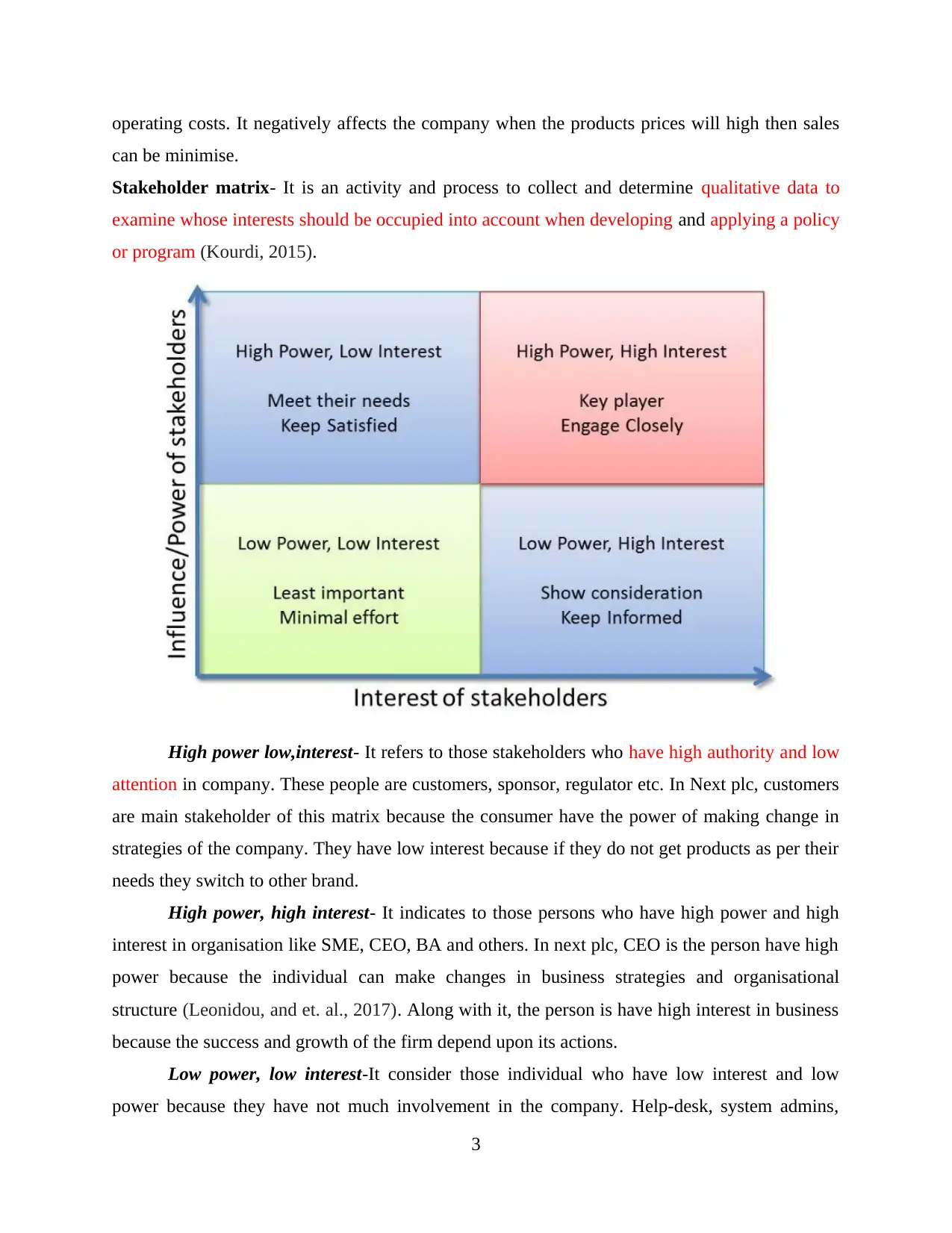
operating costs. It negatively affects the company when the products prices will high then sales
can be minimise.
Stakeholder matrix- It is an activity and process to collect and determine qualitative data to
examine whose interests should be occupied into account when developing and applying a policy
or program (Kourdi, 2015).
High power low,interest- It refers to those stakeholders who have high authority and low
attention in company. These people are customers, sponsor, regulator etc. In Next plc, customers
are main stakeholder of this matrix because the consumer have the power of making change in
strategies of the company. They have low interest because if they do not get products as per their
needs they switch to other brand.
High power, high interest- It indicates to those persons who have high power and high
interest in organisation like SME, CEO, BA and others. In next plc, CEO is the person have high
power because the individual can make changes in business strategies and organisational
structure (Leonidou, and et. al., 2017). Along with it, the person is have high interest in business
because the success and growth of the firm depend upon its actions.
Low power, low interest-It consider those individual who have low interest and low
power because they have not much involvement in the company. Help-desk, system admins,
3
can be minimise.
Stakeholder matrix- It is an activity and process to collect and determine qualitative data to
examine whose interests should be occupied into account when developing and applying a policy
or program (Kourdi, 2015).
High power low,interest- It refers to those stakeholders who have high authority and low
attention in company. These people are customers, sponsor, regulator etc. In Next plc, customers
are main stakeholder of this matrix because the consumer have the power of making change in
strategies of the company. They have low interest because if they do not get products as per their
needs they switch to other brand.
High power, high interest- It indicates to those persons who have high power and high
interest in organisation like SME, CEO, BA and others. In next plc, CEO is the person have high
power because the individual can make changes in business strategies and organisational
structure (Leonidou, and et. al., 2017). Along with it, the person is have high interest in business
because the success and growth of the firm depend upon its actions.
Low power, low interest-It consider those individual who have low interest and low
power because they have not much involvement in the company. Help-desk, system admins,
3

suppliers etc. are these kind of stakeholder. In Next plc, suppliers considers these kind of
individuals because they have not high involvement in business of the company.
Low power, high interest- It consist developer, internal users, trainer, tester, employees
etc. as stakeholder of Next plc (Martinez-Simarro, Devece and Llopis-Albert, 2015). Employees
have high interest because there are responsible for their work but they have not power because
they are administrate and direct by senior authorities of the firm.
M1. Critically analyse the macro environment to determine and inform strategic management
decisions
PESTEL analysis is beneficial because it offers simple and easy to use structure to
analyse impact upon business (Kane, and et. al., 2015). It helps in assessing allegation of
incoming new markets both countrywide and international. The main drawback of this analysis is
that this activity has to be organised regular base to be effective and often companies do not
devise the investment. The disadvantage of it is that this analysis is only supported to assessment
of the external environment so the outcomes obtained from this concept are not useful and
complete.
TASK 2
P2. Analysis of internal environment and capabilities of the company
NEXT PLC is the second multinational clothing retailer in UK, deals with product like
apparels, accessories, footwear of women, men and kids and home products also. It engaged in
retailers, online shopping facilities. NEXT PLC store is widely located in UK and middle east
countries. To evaluate micro and macro business environment, SWOT analysis of NEXT PLC to
be done, to identify the strength, weakness, opportunities and threat.
Strength Weakness
NEXT PLC comes with product
innovation with excellence market
performance and best customer service
as mostly active website in social
media.
Distribution channel is so strong and
fastest delivery in same day of products
NEXT PLC is not investing in market
research as their competitor to known
costumer need, they are using their old
featured market concept and making
product likewise.
Not investing and upgrading new
technology in their firm, these result
4
individuals because they have not high involvement in business of the company.
Low power, high interest- It consist developer, internal users, trainer, tester, employees
etc. as stakeholder of Next plc (Martinez-Simarro, Devece and Llopis-Albert, 2015). Employees
have high interest because there are responsible for their work but they have not power because
they are administrate and direct by senior authorities of the firm.
M1. Critically analyse the macro environment to determine and inform strategic management
decisions
PESTEL analysis is beneficial because it offers simple and easy to use structure to
analyse impact upon business (Kane, and et. al., 2015). It helps in assessing allegation of
incoming new markets both countrywide and international. The main drawback of this analysis is
that this activity has to be organised regular base to be effective and often companies do not
devise the investment. The disadvantage of it is that this analysis is only supported to assessment
of the external environment so the outcomes obtained from this concept are not useful and
complete.
TASK 2
P2. Analysis of internal environment and capabilities of the company
NEXT PLC is the second multinational clothing retailer in UK, deals with product like
apparels, accessories, footwear of women, men and kids and home products also. It engaged in
retailers, online shopping facilities. NEXT PLC store is widely located in UK and middle east
countries. To evaluate micro and macro business environment, SWOT analysis of NEXT PLC to
be done, to identify the strength, weakness, opportunities and threat.
Strength Weakness
NEXT PLC comes with product
innovation with excellence market
performance and best customer service
as mostly active website in social
media.
Distribution channel is so strong and
fastest delivery in same day of products
NEXT PLC is not investing in market
research as their competitor to known
costumer need, they are using their old
featured market concept and making
product likewise.
Not investing and upgrading new
technology in their firm, these result
4
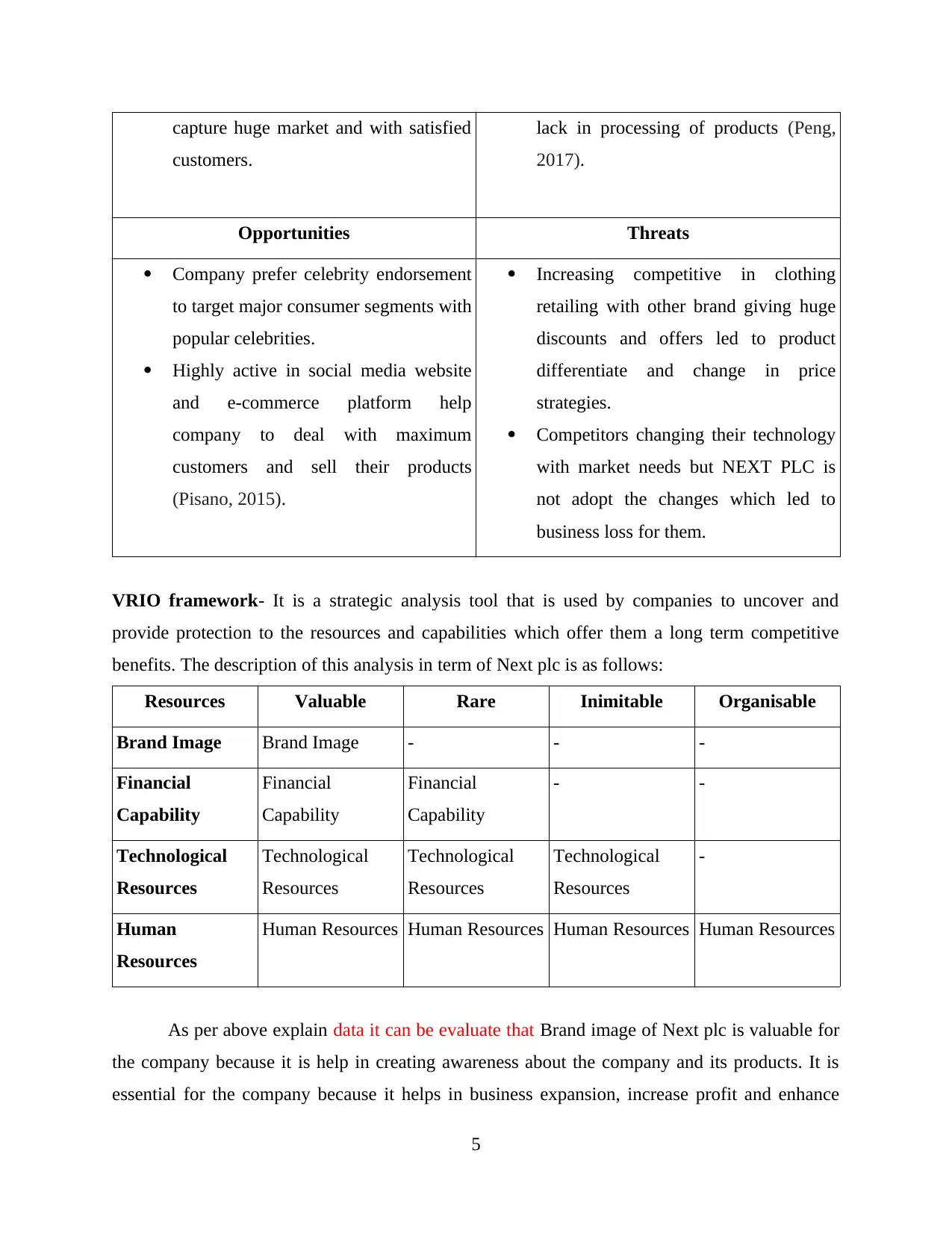
capture huge market and with satisfied
customers.
lack in processing of products (Peng,
2017).
Opportunities Threats
Company prefer celebrity endorsement
to target major consumer segments with
popular celebrities.
Highly active in social media website
and e-commerce platform help
company to deal with maximum
customers and sell their products
(Pisano, 2015).
Increasing competitive in clothing
retailing with other brand giving huge
discounts and offers led to product
differentiate and change in price
strategies.
Competitors changing their technology
with market needs but NEXT PLC is
not adopt the changes which led to
business loss for them.
VRIO framework- It is a strategic analysis tool that is used by companies to uncover and
provide protection to the resources and capabilities which offer them a long term competitive
benefits. The description of this analysis in term of Next plc is as follows:
Resources Valuable Rare Inimitable Organisable
Brand Image Brand Image - - -
Financial
Capability
Financial
Capability
Financial
Capability
- -
Technological
Resources
Technological
Resources
Technological
Resources
Technological
Resources
-
Human
Resources
Human Resources Human Resources Human Resources Human Resources
As per above explain data it can be evaluate that Brand image of Next plc is valuable for
the company because it is help in creating awareness about the company and its products. It is
essential for the company because it helps in business expansion, increase profit and enhance
5
customers.
lack in processing of products (Peng,
2017).
Opportunities Threats
Company prefer celebrity endorsement
to target major consumer segments with
popular celebrities.
Highly active in social media website
and e-commerce platform help
company to deal with maximum
customers and sell their products
(Pisano, 2015).
Increasing competitive in clothing
retailing with other brand giving huge
discounts and offers led to product
differentiate and change in price
strategies.
Competitors changing their technology
with market needs but NEXT PLC is
not adopt the changes which led to
business loss for them.
VRIO framework- It is a strategic analysis tool that is used by companies to uncover and
provide protection to the resources and capabilities which offer them a long term competitive
benefits. The description of this analysis in term of Next plc is as follows:
Resources Valuable Rare Inimitable Organisable
Brand Image Brand Image - - -
Financial
Capability
Financial
Capability
Financial
Capability
- -
Technological
Resources
Technological
Resources
Technological
Resources
Technological
Resources
-
Human
Resources
Human Resources Human Resources Human Resources Human Resources
As per above explain data it can be evaluate that Brand image of Next plc is valuable for
the company because it is help in creating awareness about the company and its products. It is
essential for the company because it helps in business expansion, increase profit and enhance
5
Paraphrase This Document
Need a fresh take? Get an instant paraphrase of this document with our AI Paraphraser
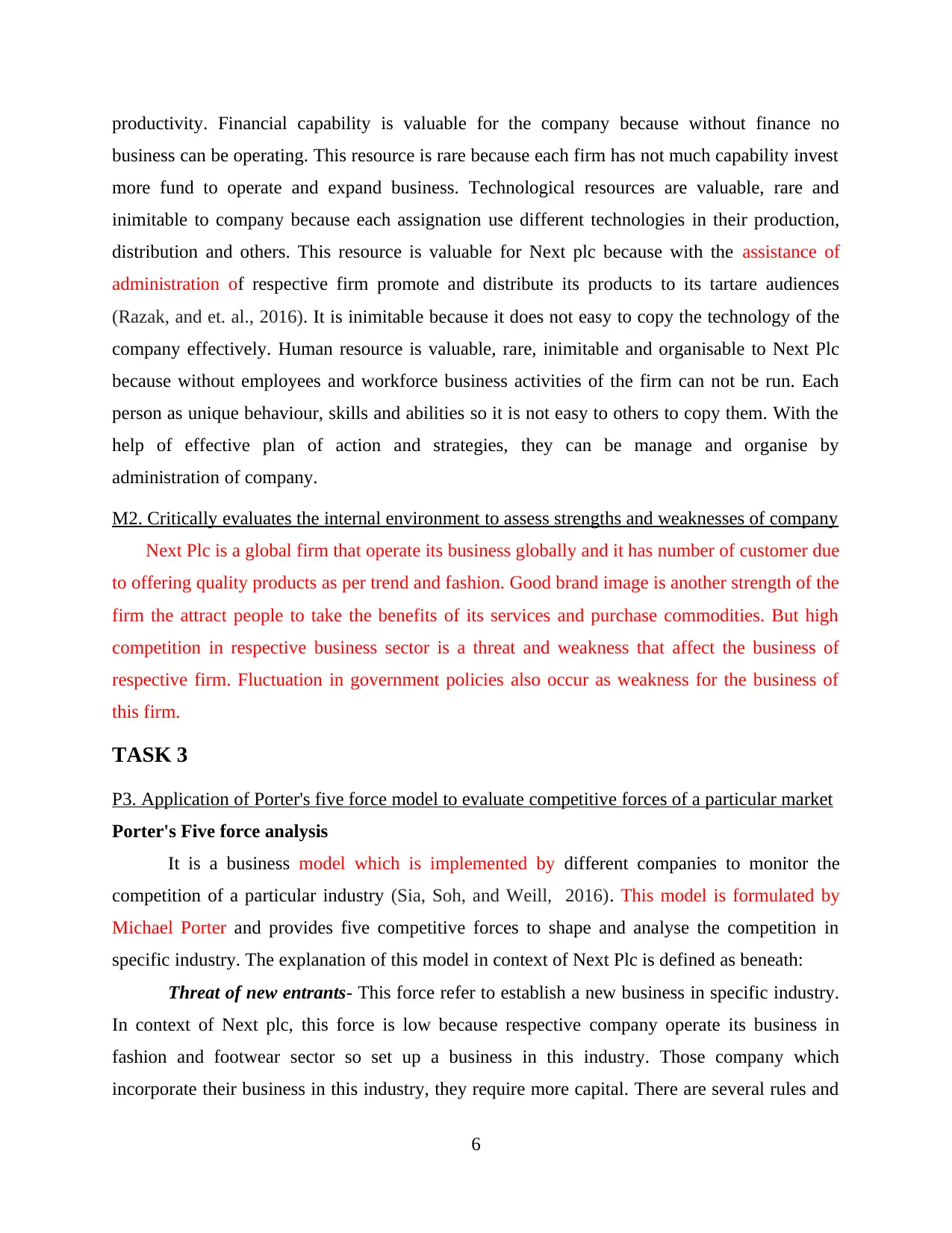
productivity. Financial capability is valuable for the company because without finance no
business can be operating. This resource is rare because each firm has not much capability invest
more fund to operate and expand business. Technological resources are valuable, rare and
inimitable to company because each assignation use different technologies in their production,
distribution and others. This resource is valuable for Next plc because with the assistance of
administration of respective firm promote and distribute its products to its tartare audiences
(Razak, and et. al., 2016). It is inimitable because it does not easy to copy the technology of the
company effectively. Human resource is valuable, rare, inimitable and organisable to Next Plc
because without employees and workforce business activities of the firm can not be run. Each
person as unique behaviour, skills and abilities so it is not easy to others to copy them. With the
help of effective plan of action and strategies, they can be manage and organise by
administration of company.
M2. Critically evaluates the internal environment to assess strengths and weaknesses of company
Next Plc is a global firm that operate its business globally and it has number of customer due
to offering quality products as per trend and fashion. Good brand image is another strength of the
firm the attract people to take the benefits of its services and purchase commodities. But high
competition in respective business sector is a threat and weakness that affect the business of
respective firm. Fluctuation in government policies also occur as weakness for the business of
this firm.
TASK 3
P3. Application of Porter's five force model to evaluate competitive forces of a particular market
Porter's Five force analysis
It is a business model which is implemented by different companies to monitor the
competition of a particular industry (Sia, Soh, and Weill, 2016). This model is formulated by
Michael Porter and provides five competitive forces to shape and analyse the competition in
specific industry. The explanation of this model in context of Next Plc is defined as beneath:
Threat of new entrants- This force refer to establish a new business in specific industry.
In context of Next plc, this force is low because respective company operate its business in
fashion and footwear sector so set up a business in this industry. Those company which
incorporate their business in this industry, they require more capital. There are several rules and
6
business can be operating. This resource is rare because each firm has not much capability invest
more fund to operate and expand business. Technological resources are valuable, rare and
inimitable to company because each assignation use different technologies in their production,
distribution and others. This resource is valuable for Next plc because with the assistance of
administration of respective firm promote and distribute its products to its tartare audiences
(Razak, and et. al., 2016). It is inimitable because it does not easy to copy the technology of the
company effectively. Human resource is valuable, rare, inimitable and organisable to Next Plc
because without employees and workforce business activities of the firm can not be run. Each
person as unique behaviour, skills and abilities so it is not easy to others to copy them. With the
help of effective plan of action and strategies, they can be manage and organise by
administration of company.
M2. Critically evaluates the internal environment to assess strengths and weaknesses of company
Next Plc is a global firm that operate its business globally and it has number of customer due
to offering quality products as per trend and fashion. Good brand image is another strength of the
firm the attract people to take the benefits of its services and purchase commodities. But high
competition in respective business sector is a threat and weakness that affect the business of
respective firm. Fluctuation in government policies also occur as weakness for the business of
this firm.
TASK 3
P3. Application of Porter's five force model to evaluate competitive forces of a particular market
Porter's Five force analysis
It is a business model which is implemented by different companies to monitor the
competition of a particular industry (Sia, Soh, and Weill, 2016). This model is formulated by
Michael Porter and provides five competitive forces to shape and analyse the competition in
specific industry. The explanation of this model in context of Next Plc is defined as beneath:
Threat of new entrants- This force refer to establish a new business in specific industry.
In context of Next plc, this force is low because respective company operate its business in
fashion and footwear sector so set up a business in this industry. Those company which
incorporate their business in this industry, they require more capital. There are several rules and
6
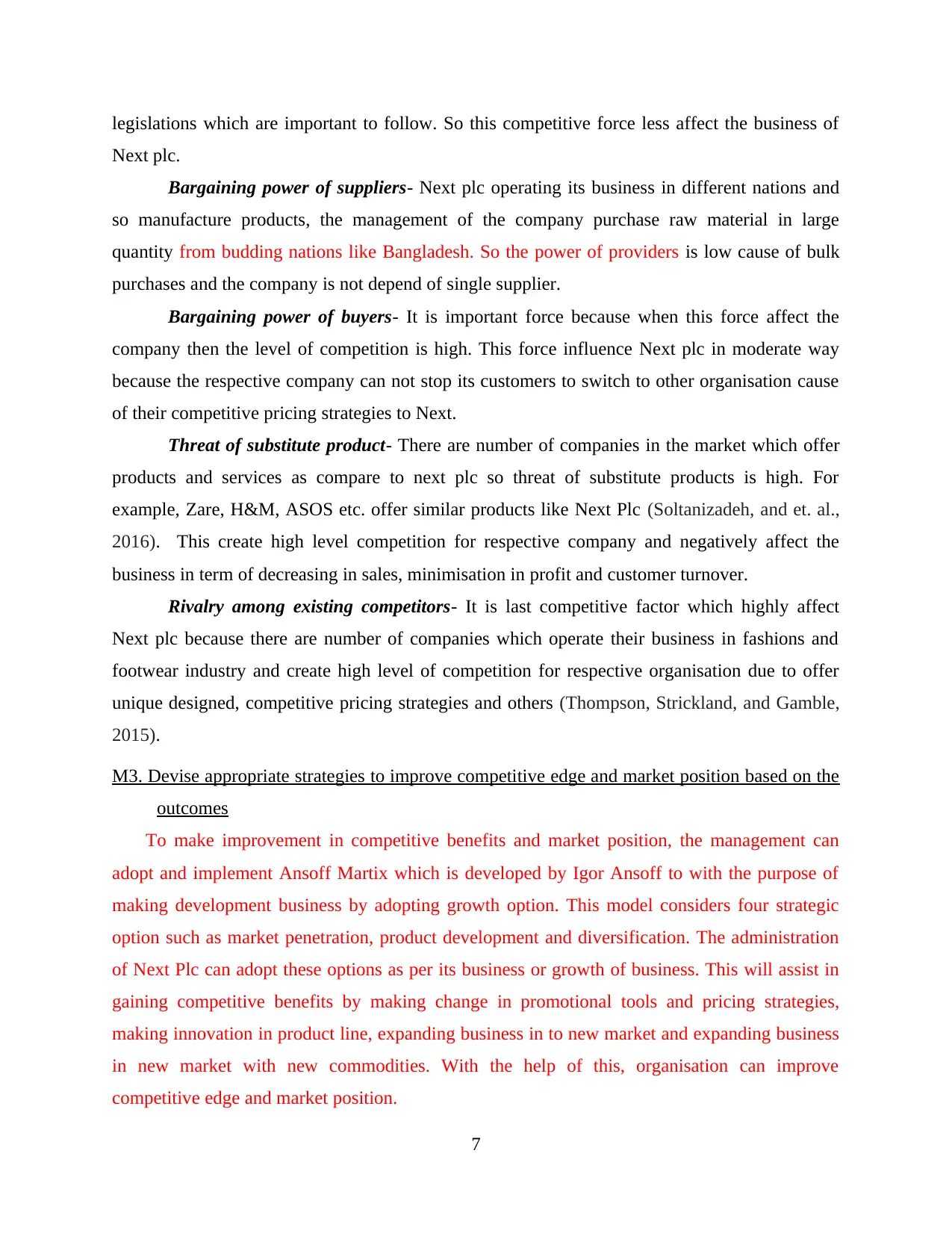
legislations which are important to follow. So this competitive force less affect the business of
Next plc.
Bargaining power of suppliers- Next plc operating its business in different nations and
so manufacture products, the management of the company purchase raw material in large
quantity from budding nations like Bangladesh. So the power of providers is low cause of bulk
purchases and the company is not depend of single supplier.
Bargaining power of buyers- It is important force because when this force affect the
company then the level of competition is high. This force influence Next plc in moderate way
because the respective company can not stop its customers to switch to other organisation cause
of their competitive pricing strategies to Next.
Threat of substitute product- There are number of companies in the market which offer
products and services as compare to next plc so threat of substitute products is high. For
example, Zare, H&M, ASOS etc. offer similar products like Next Plc (Soltanizadeh, and et. al.,
2016). This create high level competition for respective company and negatively affect the
business in term of decreasing in sales, minimisation in profit and customer turnover.
Rivalry among existing competitors- It is last competitive factor which highly affect
Next plc because there are number of companies which operate their business in fashions and
footwear industry and create high level of competition for respective organisation due to offer
unique designed, competitive pricing strategies and others (Thompson, Strickland, and Gamble,
2015).
M3. Devise appropriate strategies to improve competitive edge and market position based on the
outcomes
To make improvement in competitive benefits and market position, the management can
adopt and implement Ansoff Martix which is developed by Igor Ansoff to with the purpose of
making development business by adopting growth option. This model considers four strategic
option such as market penetration, product development and diversification. The administration
of Next Plc can adopt these options as per its business or growth of business. This will assist in
gaining competitive benefits by making change in promotional tools and pricing strategies,
making innovation in product line, expanding business in to new market and expanding business
in new market with new commodities. With the help of this, organisation can improve
competitive edge and market position.
7
Next plc.
Bargaining power of suppliers- Next plc operating its business in different nations and
so manufacture products, the management of the company purchase raw material in large
quantity from budding nations like Bangladesh. So the power of providers is low cause of bulk
purchases and the company is not depend of single supplier.
Bargaining power of buyers- It is important force because when this force affect the
company then the level of competition is high. This force influence Next plc in moderate way
because the respective company can not stop its customers to switch to other organisation cause
of their competitive pricing strategies to Next.
Threat of substitute product- There are number of companies in the market which offer
products and services as compare to next plc so threat of substitute products is high. For
example, Zare, H&M, ASOS etc. offer similar products like Next Plc (Soltanizadeh, and et. al.,
2016). This create high level competition for respective company and negatively affect the
business in term of decreasing in sales, minimisation in profit and customer turnover.
Rivalry among existing competitors- It is last competitive factor which highly affect
Next plc because there are number of companies which operate their business in fashions and
footwear industry and create high level of competition for respective organisation due to offer
unique designed, competitive pricing strategies and others (Thompson, Strickland, and Gamble,
2015).
M3. Devise appropriate strategies to improve competitive edge and market position based on the
outcomes
To make improvement in competitive benefits and market position, the management can
adopt and implement Ansoff Martix which is developed by Igor Ansoff to with the purpose of
making development business by adopting growth option. This model considers four strategic
option such as market penetration, product development and diversification. The administration
of Next Plc can adopt these options as per its business or growth of business. This will assist in
gaining competitive benefits by making change in promotional tools and pricing strategies,
making innovation in product line, expanding business in to new market and expanding business
in new market with new commodities. With the help of this, organisation can improve
competitive edge and market position.
7
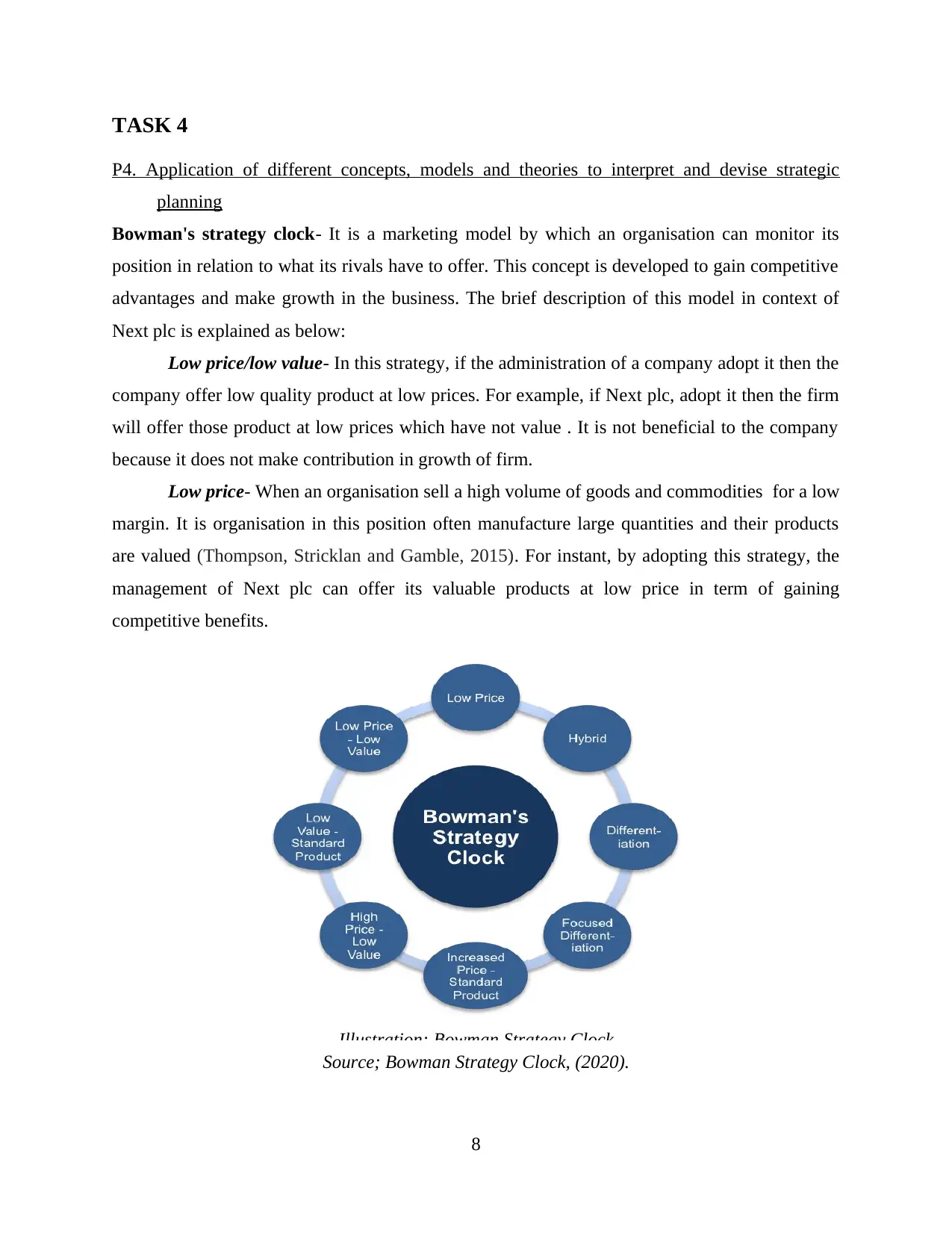
TASK 4
P4. Application of different concepts, models and theories to interpret and devise strategic
planning
Bowman's strategy clock- It is a marketing model by which an organisation can monitor its
position in relation to what its rivals have to offer. This concept is developed to gain competitive
advantages and make growth in the business. The brief description of this model in context of
Next plc is explained as below:
Low price/low value- In this strategy, if the administration of a company adopt it then the
company offer low quality product at low prices. For example, if Next plc, adopt it then the firm
will offer those product at low prices which have not value . It is not beneficial to the company
because it does not make contribution in growth of firm.
Low price- When an organisation sell a high volume of goods and commodities for a low
margin. It is organisation in this position often manufacture large quantities and their products
are valued (Thompson, Stricklan and Gamble, 2015). For instant, by adopting this strategy, the
management of Next plc can offer its valuable products at low price in term of gaining
competitive benefits.
Source; Bowman Strategy Clock, (2020).
8
Illustration: Bowman Strategy Clock
P4. Application of different concepts, models and theories to interpret and devise strategic
planning
Bowman's strategy clock- It is a marketing model by which an organisation can monitor its
position in relation to what its rivals have to offer. This concept is developed to gain competitive
advantages and make growth in the business. The brief description of this model in context of
Next plc is explained as below:
Low price/low value- In this strategy, if the administration of a company adopt it then the
company offer low quality product at low prices. For example, if Next plc, adopt it then the firm
will offer those product at low prices which have not value . It is not beneficial to the company
because it does not make contribution in growth of firm.
Low price- When an organisation sell a high volume of goods and commodities for a low
margin. It is organisation in this position often manufacture large quantities and their products
are valued (Thompson, Stricklan and Gamble, 2015). For instant, by adopting this strategy, the
management of Next plc can offer its valuable products at low price in term of gaining
competitive benefits.
Source; Bowman Strategy Clock, (2020).
8
Illustration: Bowman Strategy Clock
Secure Best Marks with AI Grader
Need help grading? Try our AI Grader for instant feedback on your assignments.
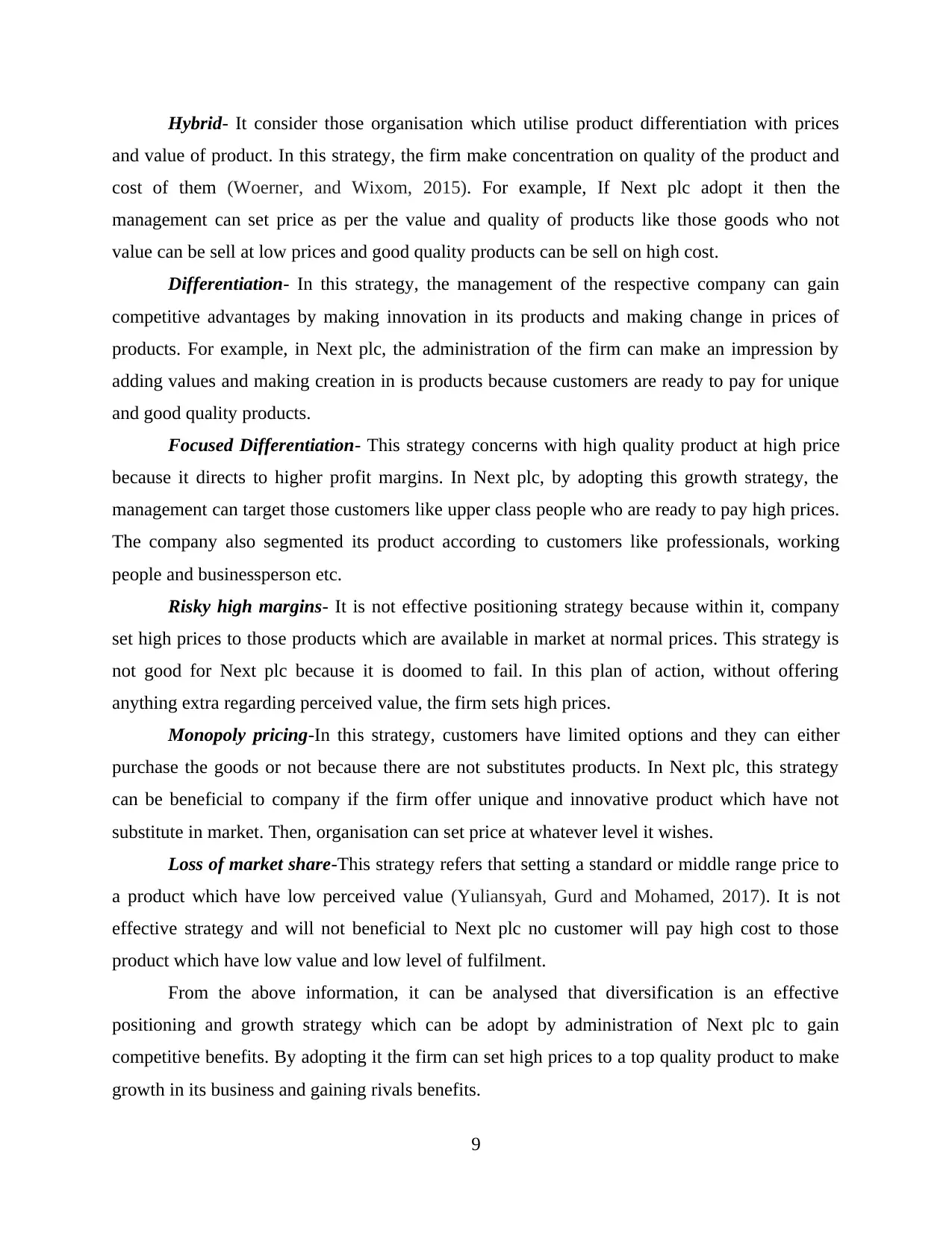
Hybrid- It consider those organisation which utilise product differentiation with prices
and value of product. In this strategy, the firm make concentration on quality of the product and
cost of them (Woerner, and Wixom, 2015). For example, If Next plc adopt it then the
management can set price as per the value and quality of products like those goods who not
value can be sell at low prices and good quality products can be sell on high cost.
Differentiation- In this strategy, the management of the respective company can gain
competitive advantages by making innovation in its products and making change in prices of
products. For example, in Next plc, the administration of the firm can make an impression by
adding values and making creation in is products because customers are ready to pay for unique
and good quality products.
Focused Differentiation- This strategy concerns with high quality product at high price
because it directs to higher profit margins. In Next plc, by adopting this growth strategy, the
management can target those customers like upper class people who are ready to pay high prices.
The company also segmented its product according to customers like professionals, working
people and businessperson etc.
Risky high margins- It is not effective positioning strategy because within it, company
set high prices to those products which are available in market at normal prices. This strategy is
not good for Next plc because it is doomed to fail. In this plan of action, without offering
anything extra regarding perceived value, the firm sets high prices.
Monopoly pricing-In this strategy, customers have limited options and they can either
purchase the goods or not because there are not substitutes products. In Next plc, this strategy
can be beneficial to company if the firm offer unique and innovative product which have not
substitute in market. Then, organisation can set price at whatever level it wishes.
Loss of market share-This strategy refers that setting a standard or middle range price to
a product which have low perceived value (Yuliansyah, Gurd and Mohamed, 2017). It is not
effective strategy and will not beneficial to Next plc no customer will pay high cost to those
product which have low value and low level of fulfilment.
From the above information, it can be analysed that diversification is an effective
positioning and growth strategy which can be adopt by administration of Next plc to gain
competitive benefits. By adopting it the firm can set high prices to a top quality product to make
growth in its business and gaining rivals benefits.
9
and value of product. In this strategy, the firm make concentration on quality of the product and
cost of them (Woerner, and Wixom, 2015). For example, If Next plc adopt it then the
management can set price as per the value and quality of products like those goods who not
value can be sell at low prices and good quality products can be sell on high cost.
Differentiation- In this strategy, the management of the respective company can gain
competitive advantages by making innovation in its products and making change in prices of
products. For example, in Next plc, the administration of the firm can make an impression by
adding values and making creation in is products because customers are ready to pay for unique
and good quality products.
Focused Differentiation- This strategy concerns with high quality product at high price
because it directs to higher profit margins. In Next plc, by adopting this growth strategy, the
management can target those customers like upper class people who are ready to pay high prices.
The company also segmented its product according to customers like professionals, working
people and businessperson etc.
Risky high margins- It is not effective positioning strategy because within it, company
set high prices to those products which are available in market at normal prices. This strategy is
not good for Next plc because it is doomed to fail. In this plan of action, without offering
anything extra regarding perceived value, the firm sets high prices.
Monopoly pricing-In this strategy, customers have limited options and they can either
purchase the goods or not because there are not substitutes products. In Next plc, this strategy
can be beneficial to company if the firm offer unique and innovative product which have not
substitute in market. Then, organisation can set price at whatever level it wishes.
Loss of market share-This strategy refers that setting a standard or middle range price to
a product which have low perceived value (Yuliansyah, Gurd and Mohamed, 2017). It is not
effective strategy and will not beneficial to Next plc no customer will pay high cost to those
product which have low value and low level of fulfilment.
From the above information, it can be analysed that diversification is an effective
positioning and growth strategy which can be adopt by administration of Next plc to gain
competitive benefits. By adopting it the firm can set high prices to a top quality product to make
growth in its business and gaining rivals benefits.
9
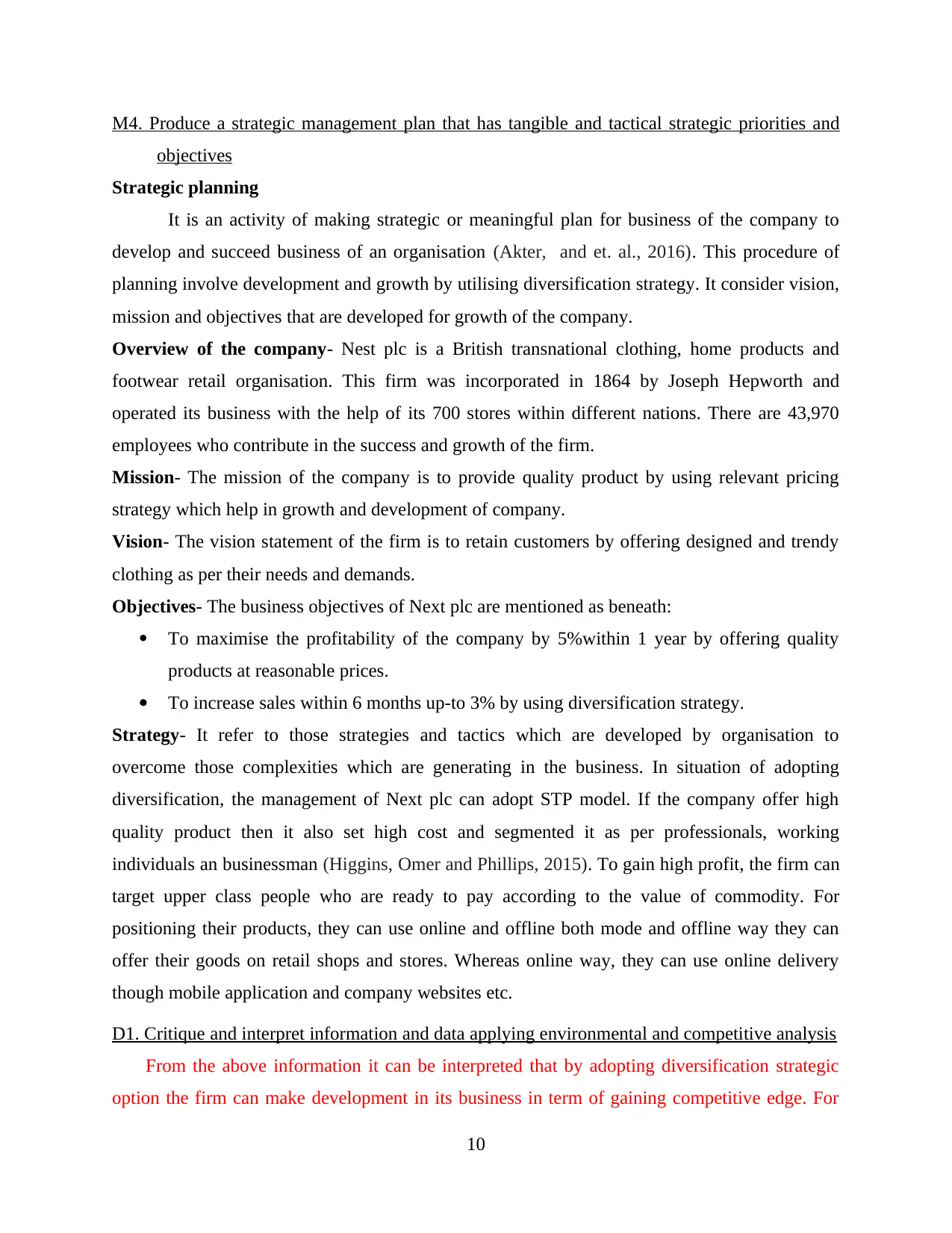
M4. Produce a strategic management plan that has tangible and tactical strategic priorities and
objectives
Strategic planning
It is an activity of making strategic or meaningful plan for business of the company to
develop and succeed business of an organisation (Akter, and et. al., 2016). This procedure of
planning involve development and growth by utilising diversification strategy. It consider vision,
mission and objectives that are developed for growth of the company.
Overview of the company- Nest plc is a British transnational clothing, home products and
footwear retail organisation. This firm was incorporated in 1864 by Joseph Hepworth and
operated its business with the help of its 700 stores within different nations. There are 43,970
employees who contribute in the success and growth of the firm.
Mission- The mission of the company is to provide quality product by using relevant pricing
strategy which help in growth and development of company.
Vision- The vision statement of the firm is to retain customers by offering designed and trendy
clothing as per their needs and demands.
Objectives- The business objectives of Next plc are mentioned as beneath:
To maximise the profitability of the company by 5%within 1 year by offering quality
products at reasonable prices.
To increase sales within 6 months up-to 3% by using diversification strategy.
Strategy- It refer to those strategies and tactics which are developed by organisation to
overcome those complexities which are generating in the business. In situation of adopting
diversification, the management of Next plc can adopt STP model. If the company offer high
quality product then it also set high cost and segmented it as per professionals, working
individuals an businessman (Higgins, Omer and Phillips, 2015). To gain high profit, the firm can
target upper class people who are ready to pay according to the value of commodity. For
positioning their products, they can use online and offline both mode and offline way they can
offer their goods on retail shops and stores. Whereas online way, they can use online delivery
though mobile application and company websites etc.
D1. Critique and interpret information and data applying environmental and competitive analysis
From the above information it can be interpreted that by adopting diversification strategic
option the firm can make development in its business in term of gaining competitive edge. For
10
objectives
Strategic planning
It is an activity of making strategic or meaningful plan for business of the company to
develop and succeed business of an organisation (Akter, and et. al., 2016). This procedure of
planning involve development and growth by utilising diversification strategy. It consider vision,
mission and objectives that are developed for growth of the company.
Overview of the company- Nest plc is a British transnational clothing, home products and
footwear retail organisation. This firm was incorporated in 1864 by Joseph Hepworth and
operated its business with the help of its 700 stores within different nations. There are 43,970
employees who contribute in the success and growth of the firm.
Mission- The mission of the company is to provide quality product by using relevant pricing
strategy which help in growth and development of company.
Vision- The vision statement of the firm is to retain customers by offering designed and trendy
clothing as per their needs and demands.
Objectives- The business objectives of Next plc are mentioned as beneath:
To maximise the profitability of the company by 5%within 1 year by offering quality
products at reasonable prices.
To increase sales within 6 months up-to 3% by using diversification strategy.
Strategy- It refer to those strategies and tactics which are developed by organisation to
overcome those complexities which are generating in the business. In situation of adopting
diversification, the management of Next plc can adopt STP model. If the company offer high
quality product then it also set high cost and segmented it as per professionals, working
individuals an businessman (Higgins, Omer and Phillips, 2015). To gain high profit, the firm can
target upper class people who are ready to pay according to the value of commodity. For
positioning their products, they can use online and offline both mode and offline way they can
offer their goods on retail shops and stores. Whereas online way, they can use online delivery
though mobile application and company websites etc.
D1. Critique and interpret information and data applying environmental and competitive analysis
From the above information it can be interpreted that by adopting diversification strategic
option the firm can make development in its business in term of gaining competitive edge. For
10
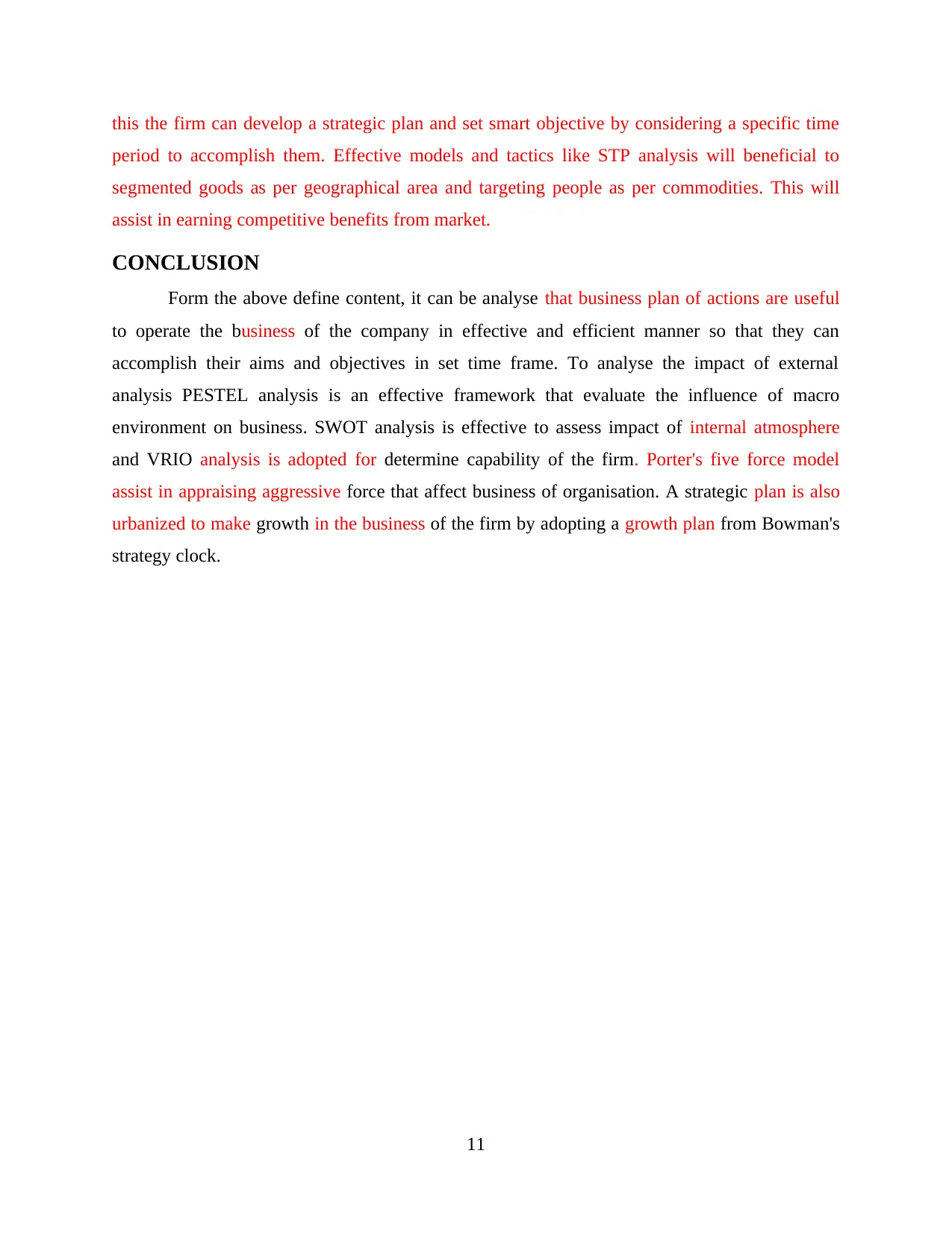
this the firm can develop a strategic plan and set smart objective by considering a specific time
period to accomplish them. Effective models and tactics like STP analysis will beneficial to
segmented goods as per geographical area and targeting people as per commodities. This will
assist in earning competitive benefits from market.
CONCLUSION
Form the above define content, it can be analyse that business plan of actions are useful
to operate the business of the company in effective and efficient manner so that they can
accomplish their aims and objectives in set time frame. To analyse the impact of external
analysis PESTEL analysis is an effective framework that evaluate the influence of macro
environment on business. SWOT analysis is effective to assess impact of internal atmosphere
and VRIO analysis is adopted for determine capability of the firm. Porter's five force model
assist in appraising aggressive force that affect business of organisation. A strategic plan is also
urbanized to make growth in the business of the firm by adopting a growth plan from Bowman's
strategy clock.
11
period to accomplish them. Effective models and tactics like STP analysis will beneficial to
segmented goods as per geographical area and targeting people as per commodities. This will
assist in earning competitive benefits from market.
CONCLUSION
Form the above define content, it can be analyse that business plan of actions are useful
to operate the business of the company in effective and efficient manner so that they can
accomplish their aims and objectives in set time frame. To analyse the impact of external
analysis PESTEL analysis is an effective framework that evaluate the influence of macro
environment on business. SWOT analysis is effective to assess impact of internal atmosphere
and VRIO analysis is adopted for determine capability of the firm. Porter's five force model
assist in appraising aggressive force that affect business of organisation. A strategic plan is also
urbanized to make growth in the business of the firm by adopting a growth plan from Bowman's
strategy clock.
11
Paraphrase This Document
Need a fresh take? Get an instant paraphrase of this document with our AI Paraphraser

REFERENCES
Books & Journals
Akter, S., and et. al., 2016. How to improve firm performance using big data analytics capability
and business strategy alignment?. International Journal of Production Economics. 182.
pp.113-131.
Higgins, D., Omer, T.C. and Phillips, J.D., 2015. The influence of a firm's business strategy on
its tax aggressiveness. Contemporary Accounting Research. 32(2). pp.674-702.
12
Books & Journals
Akter, S., and et. al., 2016. How to improve firm performance using big data analytics capability
and business strategy alignment?. International Journal of Production Economics. 182.
pp.113-131.
Higgins, D., Omer, T.C. and Phillips, J.D., 2015. The influence of a firm's business strategy on
its tax aggressiveness. Contemporary Accounting Research. 32(2). pp.674-702.
12
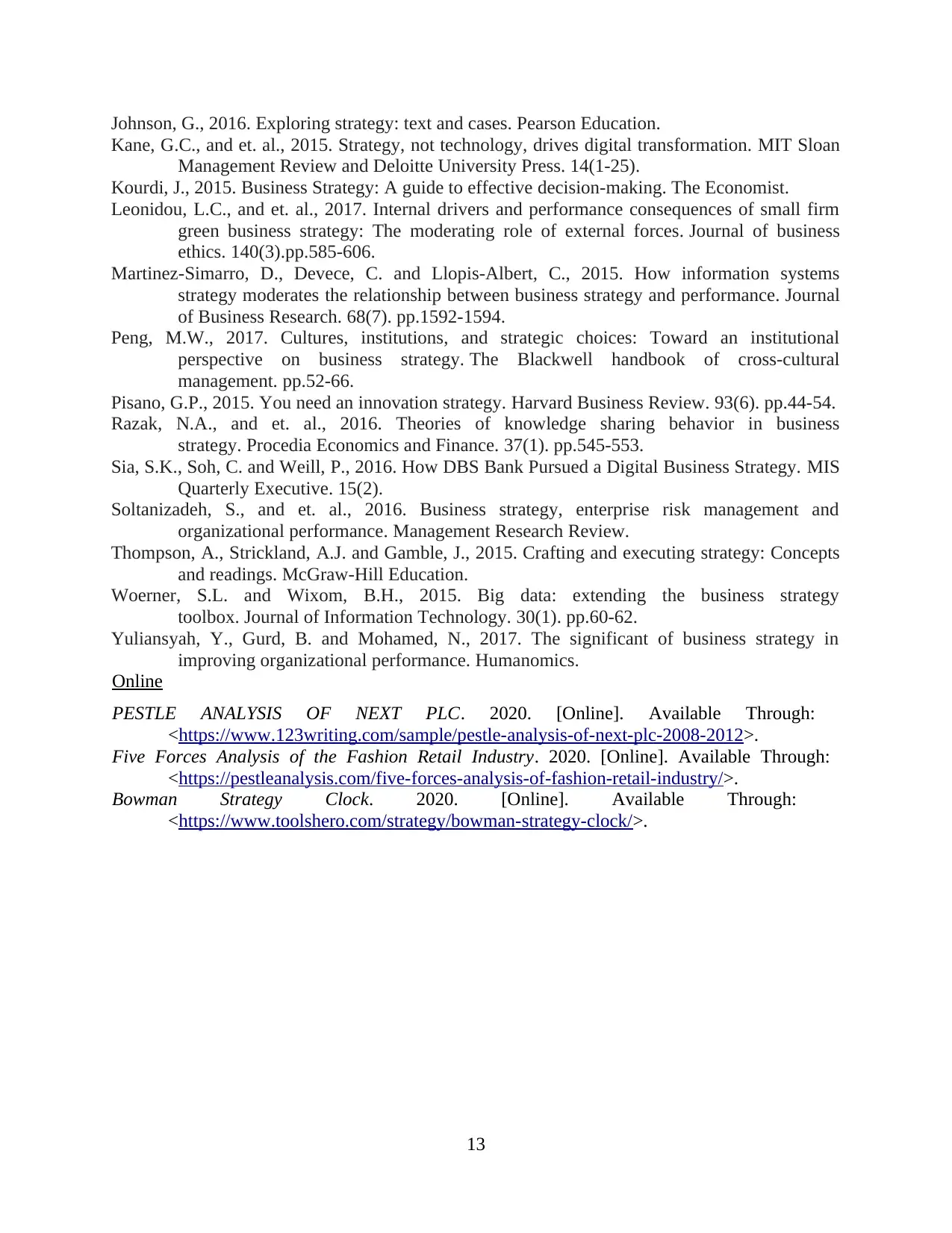
Johnson, G., 2016. Exploring strategy: text and cases. Pearson Education.
Kane, G.C., and et. al., 2015. Strategy, not technology, drives digital transformation. MIT Sloan
Management Review and Deloitte University Press. 14(1-25).
Kourdi, J., 2015. Business Strategy: A guide to effective decision-making. The Economist.
Leonidou, L.C., and et. al., 2017. Internal drivers and performance consequences of small firm
green business strategy: The moderating role of external forces. Journal of business
ethics. 140(3).pp.585-606.
Martinez-Simarro, D., Devece, C. and Llopis-Albert, C., 2015. How information systems
strategy moderates the relationship between business strategy and performance. Journal
of Business Research. 68(7). pp.1592-1594.
Peng, M.W., 2017. Cultures, institutions, and strategic choices: Toward an institutional
perspective on business strategy. The Blackwell handbook of cross‐cultural
management. pp.52-66.
Pisano, G.P., 2015. You need an innovation strategy. Harvard Business Review. 93(6). pp.44-54.
Razak, N.A., and et. al., 2016. Theories of knowledge sharing behavior in business
strategy. Procedia Economics and Finance. 37(1). pp.545-553.
Sia, S.K., Soh, C. and Weill, P., 2016. How DBS Bank Pursued a Digital Business Strategy. MIS
Quarterly Executive. 15(2).
Soltanizadeh, S., and et. al., 2016. Business strategy, enterprise risk management and
organizational performance. Management Research Review.
Thompson, A., Strickland, A.J. and Gamble, J., 2015. Crafting and executing strategy: Concepts
and readings. McGraw-Hill Education.
Woerner, S.L. and Wixom, B.H., 2015. Big data: extending the business strategy
toolbox. Journal of Information Technology. 30(1). pp.60-62.
Yuliansyah, Y., Gurd, B. and Mohamed, N., 2017. The significant of business strategy in
improving organizational performance. Humanomics.
Online
PESTLE ANALYSIS OF NEXT PLC. 2020. [Online]. Available Through:
<https://www.123writing.com/sample/pestle-analysis-of-next-plc-2008-2012>.
Five Forces Analysis of the Fashion Retail Industry. 2020. [Online]. Available Through:
<https://pestleanalysis.com/five-forces-analysis-of-fashion-retail-industry/>.
Bowman Strategy Clock. 2020. [Online]. Available Through:
<https://www.toolshero.com/strategy/bowman-strategy-clock/>.
13
Kane, G.C., and et. al., 2015. Strategy, not technology, drives digital transformation. MIT Sloan
Management Review and Deloitte University Press. 14(1-25).
Kourdi, J., 2015. Business Strategy: A guide to effective decision-making. The Economist.
Leonidou, L.C., and et. al., 2017. Internal drivers and performance consequences of small firm
green business strategy: The moderating role of external forces. Journal of business
ethics. 140(3).pp.585-606.
Martinez-Simarro, D., Devece, C. and Llopis-Albert, C., 2015. How information systems
strategy moderates the relationship between business strategy and performance. Journal
of Business Research. 68(7). pp.1592-1594.
Peng, M.W., 2017. Cultures, institutions, and strategic choices: Toward an institutional
perspective on business strategy. The Blackwell handbook of cross‐cultural
management. pp.52-66.
Pisano, G.P., 2015. You need an innovation strategy. Harvard Business Review. 93(6). pp.44-54.
Razak, N.A., and et. al., 2016. Theories of knowledge sharing behavior in business
strategy. Procedia Economics and Finance. 37(1). pp.545-553.
Sia, S.K., Soh, C. and Weill, P., 2016. How DBS Bank Pursued a Digital Business Strategy. MIS
Quarterly Executive. 15(2).
Soltanizadeh, S., and et. al., 2016. Business strategy, enterprise risk management and
organizational performance. Management Research Review.
Thompson, A., Strickland, A.J. and Gamble, J., 2015. Crafting and executing strategy: Concepts
and readings. McGraw-Hill Education.
Woerner, S.L. and Wixom, B.H., 2015. Big data: extending the business strategy
toolbox. Journal of Information Technology. 30(1). pp.60-62.
Yuliansyah, Y., Gurd, B. and Mohamed, N., 2017. The significant of business strategy in
improving organizational performance. Humanomics.
Online
PESTLE ANALYSIS OF NEXT PLC. 2020. [Online]. Available Through:
<https://www.123writing.com/sample/pestle-analysis-of-next-plc-2008-2012>.
Five Forces Analysis of the Fashion Retail Industry. 2020. [Online]. Available Through:
<https://pestleanalysis.com/five-forces-analysis-of-fashion-retail-industry/>.
Bowman Strategy Clock. 2020. [Online]. Available Through:
<https://www.toolshero.com/strategy/bowman-strategy-clock/>.
13
1 out of 15
Related Documents
Your All-in-One AI-Powered Toolkit for Academic Success.
+13062052269
info@desklib.com
Available 24*7 on WhatsApp / Email
![[object Object]](/_next/static/media/star-bottom.7253800d.svg)
Unlock your academic potential
© 2024 | Zucol Services PVT LTD | All rights reserved.





